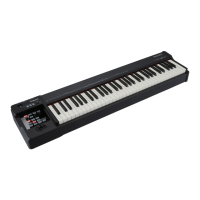13
About the Ivory Feel Keyboard
Features of an ivory feel keyboard
Traditional piano keys are made from the best materials-ivory (for white keys) and ebony (for black keys). The Ivory Feel keyboard uses the latest in
technology to reproduce the touch and feel of these materials.
An Ivory Feel keyboard oers the following features.
• We’re sure you’ll develop a fondness for the distinctive texture of these keys, which feels better the more you play them.
• Surfaces incorporate stripes of moisture-absorbing material for improved touch and playability.
• The keys feature subtle gloss and understated coloring, enhancing the look and elegance.
• The white keys are nished with a slight yellowish tinge for the look of real ivory.
Handling
• Do not write on the keyboard with any pen or other implement, and do not stamp or place any marking on the instrument. Ink will seep into the
surface lines and become unremovable.
• Do not ax stickers on the keyboard. You may be unable to remove stickers that use strong adhesives, and the adhesive may cause discoloration.
Care and maintenance
Please note the following points. Failure to do so may result in scratches on the surface nish, damaged gloss, or other discoloration or deformation.
• To remove dirt, use a soft cloth.
Using a moistened and tightly wrung-out cloth, gently wipe o any dirt.
Do not rub the surface vigorously.
• To remove stubborn dirt, use a commercially available keyboard cleaner that does not contain abrasives.
Start by wiping lightly. If the dirt does not come o, wipe using gradually increasing amounts of pressure while taking care not to scratch the keys.
• Do not use benzene, paint thinner, or alcohol on the instrument.
Eect List
Group EFX 1 EFX 2
A. PIANO
ENHANCER:
Controls the overtone structure of the high frequencies, adding sparkle
and tightness to the sound.
DAMPER RESONANCE:
On an acoustic piano, holding down the damper pedal allows other
strings to resonate in sympathy with the notes you play, creating rich
and spacious resonances. This eect simulates these sympathetic
resonances.
E. PIANO
TREMOLO:
Cyclically modulates the volume to add tremolo eect to the sound.
PHASER:
A phase-shifted sound is added to the original sound and modulated.
CLAV
AUTO WAH:
Cyclically controls a lter to create cyclic change in timbre.
OVERDRIVE:
Creates a soft distortion similar to that produced by vacuum tube
ampliers.
ORGAN
ROTARY:
The Rotary eect simulates the sound of the rotary speakers often used
with the electric organs of the past.
SPEED:
Simultaneously switch the rotational speed of the low frequency rotor
and high frequency rotor.
Controlling an External MIDI Sound Module in Piano Mode
In the RD-64’s Piano mode you can specify the MIDI channel and transmit MIDI messages such as bank select, program change, and aftertouch to an
external MIDI sound module. For details, refer to the A-88 owner’s manual sections “Setting the MIDI Transmit Channel (MIDI CHANNEL),” “Switching
Sounds,” and “Using the D-BEAM to Modify the Sound.”
If you experience problems such as stuck notes or unexpected sound on your external MIDI sound module, you can send a reset message to solve the
problem. For details, refer to the A-88 owner’s manual section “Halting Stuck Notes (PANIC).”

